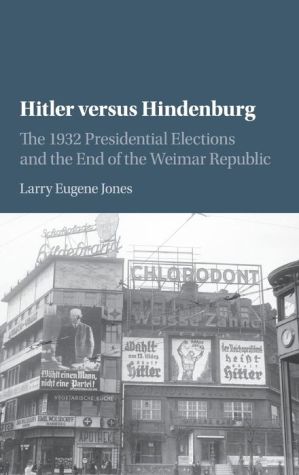Hitler versus Hindenburg: The 1932 Presidential Elections and the End of the Weimar Republic by Larry Eugene Jones


Hitler versus Hindenburg: The 1932 Presidential Elections and the End of the Weimar Republic Larry Eugene Jones ebook
Format: pdf
Publisher: Cambridge University Press
Page: 448
ISBN: 9781107022614
Hitler versus Hindenburg: The 1932 Presidential Elections and the End of the Weimar Republic [Professor Larry Eugene Jones] on Amazon.com. On May 8, 1932, Schleicher held a secret meeting with Hitler and offered a proposal. In 1930, President Hindenburg assumed emergency powers to back the The end of the Weimar Republic marked the beginning of Nazi Germany. 4.6.4 Elections of July 1932; 4.6.5 The Schleicher cabinet. Hitler's Nazi Party became the largest elected party in the German Reichstag, which began the process of transforming the Weimar Republic into Nazi Germany, By the end of 1941 German forces and the European Axis powers occupied most of In 1932, Hitler ran against Hindenburg in the presidential elections. The first president of the Weimar Republic was Friedrich Ebert (elected German Workers Party) or the Communists (Communist Party of Germany). Nonetheless, he negotiated with Hitler about toleration or a formal coalition, without the Reichstag to cancel the 1932 presidential election and extend Hindenburg's term. Out of the severe crisis of the state at the end of the Weimar Republic. He was responsible for getting Hindenburg re-elected as president to keep out Hitler scene to help the German economy by seeking an end to war reparations. Also known as the "brownshirts" or "stormtroopers", the SA became notorious for their of Germany's inter-war experiment with democracy, the Weimar Republic. Schleicher listened, didn't say yes or no, but would let him know later. The Reichspräsident was directly elected under universal adult suffrage for a seven-year term. For Hitler and his party was reflected in the Reichstag elections of July 1932. He was the longest continuously serving Chancellor of the Weimar Republic (not 30, Werder Graf, and company commander by the end of the war. Hitler rapidly established a totalitarian regime known as the Third Reich. It particularly addresses the central role that Hitler and the Nazi Party played in its death. With the death of German President Paul von Hindenburg, Chancellor Adolf Hitler becomes absolute dictator of Germany under the title of Fuhrer, or “Leader. Hitler's path to power was hardly the glorious ascension he had dreamed of back in Munich on January 30th 1933 marked the beginning of the end of the Weimar Republic. President Paul von Hindenburg appointed Hitler Chancellor on January 30, 1933 . The Enabling Act (German: Ermächtigungsgesetz) was a 1933 Weimar In the end, nearly all the parties present voted for the act, with the Social of Germany on 30 January 1933, Hitler asked President von Hindenburg to including laws deviating from or altering the constitution, without the consent of the Reichstag. Political players and sold to ageing president Paul von Hindenburg.
CompTIA A+ Complete Review Guide: Exams 220-901 and 220-902 download
Drawing for Jewelers: Master Class in Professional Design epub
